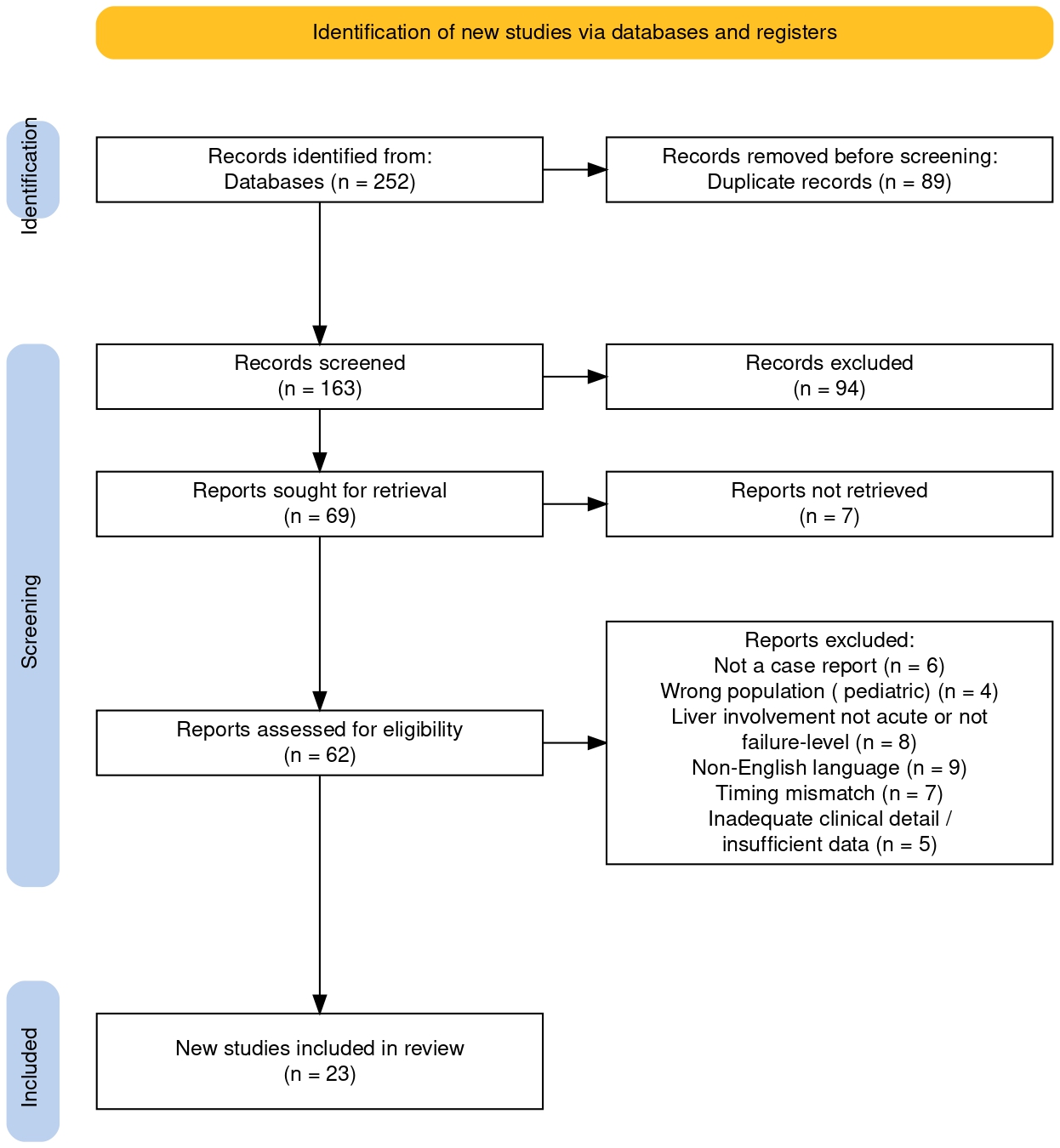Sunday Poster Session
Category: Liver
P1599 - Thyroid Storm-Induced Acute Liver Failure: A Systematic Literature Review of 23 Adult Case Reports
Sunday, October 26, 2025
3:30 PM - 7:00 PM PDT
Location: Exhibit Hall

Faizan ul Hussain Mohammed, MBBS (he/him/his)
Osmania Medical College
Farmington Hills, MI
Presenting Author(s)
Faizan ul Hussain Mohammed, MBBS1, Omer Farooq Mohammed, MBBS2, Mohammed Talha Ullah Shareef, 3, Chinmai Sri Thotti, 3
1Osmania Medical College, Karimnagar, Telangana, India; 2Osmania General Hospital and Medical College, Hyderabad, Telangana, India; 3Osmania Medical College, Hyderabad, Telangana, India
Introduction: Thyroid storm is a life-threatening emergency that can lead to multiorgan failure, including acute liver failure (ALF). While hepatic dysfunction is recognized in thyrotoxicosis, acute liver failure as a direct consequence remains poorly understood. There are no established management guidelines for this overlap, and existing literature is limited to scattered case reports. This systematic review aims to synthesize therapeutic strategies, and outcomes in adults presenting with thyroid storm complicated by ALF.
Methods: A systematic search was conducted using PubMed, Google Scholar, Embase, Scopus and Web of Science databases on case reports showing a correlation between thyroid storm and acute liver failure. After thorough quality checks, 23 adult case reports were reviewed and relevant clinical and laboratory data, treatments, and outcomes were extracted and analyzed.
Results: Among the 23 patients identified, 13 (56%) were female and 10 (43%) were male, with a mean age in the mid-40s (range 22–66). A prior history of thyroid disease was present in 15 patients, while 7 were newly diagnosed. Graves disease was the underlying etiology in 17 cases (73.9%). All patients received medical therapy, including beta-blockers, corticosteroids, antithyroid drugs, and iodine agents; 8 (34.7%) underwent therapeutic plasma exchange. Thyroidectomy was performed in 5 cases, and 3 patients underwent liver transplantation. The overall survival rate was 73.9% (17/23). Recent cases have shown a growing utilization of plasma exchange, ECMO, and double plasma adsorption methods.
Discussion: Thyroid storm induced acute liver failure remains a rare but fatal complication, with high mortality if not promptly recognized and treated. Graves disease is the predominant etiology, and management requires early thyroid-directed therapy and aggressive liver support. Advanced extracorporeal therapies may improve outcomes, but standardized protocols are lacking. This review highlights the need for early clinical suspicion and development of a protocol for managing this crisis.

Figure: PRISMA flow diagram illustrating the selection process for case reports included in the systematic review on thyroid storm-induced acute liver failure (ALF).
Disclosures:
Faizan ul Hussain Mohammed indicated no relevant financial relationships.
Omer Farooq Mohammed indicated no relevant financial relationships.
Mohammed Talha Ullah Shareef indicated no relevant financial relationships.
Chinmai Sri Thotti indicated no relevant financial relationships.
Faizan ul Hussain Mohammed, MBBS1, Omer Farooq Mohammed, MBBS2, Mohammed Talha Ullah Shareef, 3, Chinmai Sri Thotti, 3. P1599 - Thyroid Storm-Induced Acute Liver Failure: A Systematic Literature Review of 23 Adult Case Reports, ACG 2025 Annual Scientific Meeting Abstracts. Phoenix, AZ: American College of Gastroenterology.
1Osmania Medical College, Karimnagar, Telangana, India; 2Osmania General Hospital and Medical College, Hyderabad, Telangana, India; 3Osmania Medical College, Hyderabad, Telangana, India
Introduction: Thyroid storm is a life-threatening emergency that can lead to multiorgan failure, including acute liver failure (ALF). While hepatic dysfunction is recognized in thyrotoxicosis, acute liver failure as a direct consequence remains poorly understood. There are no established management guidelines for this overlap, and existing literature is limited to scattered case reports. This systematic review aims to synthesize therapeutic strategies, and outcomes in adults presenting with thyroid storm complicated by ALF.
Methods: A systematic search was conducted using PubMed, Google Scholar, Embase, Scopus and Web of Science databases on case reports showing a correlation between thyroid storm and acute liver failure. After thorough quality checks, 23 adult case reports were reviewed and relevant clinical and laboratory data, treatments, and outcomes were extracted and analyzed.
Results: Among the 23 patients identified, 13 (56%) were female and 10 (43%) were male, with a mean age in the mid-40s (range 22–66). A prior history of thyroid disease was present in 15 patients, while 7 were newly diagnosed. Graves disease was the underlying etiology in 17 cases (73.9%). All patients received medical therapy, including beta-blockers, corticosteroids, antithyroid drugs, and iodine agents; 8 (34.7%) underwent therapeutic plasma exchange. Thyroidectomy was performed in 5 cases, and 3 patients underwent liver transplantation. The overall survival rate was 73.9% (17/23). Recent cases have shown a growing utilization of plasma exchange, ECMO, and double plasma adsorption methods.
Discussion: Thyroid storm induced acute liver failure remains a rare but fatal complication, with high mortality if not promptly recognized and treated. Graves disease is the predominant etiology, and management requires early thyroid-directed therapy and aggressive liver support. Advanced extracorporeal therapies may improve outcomes, but standardized protocols are lacking. This review highlights the need for early clinical suspicion and development of a protocol for managing this crisis.

Figure: PRISMA flow diagram illustrating the selection process for case reports included in the systematic review on thyroid storm-induced acute liver failure (ALF).
Disclosures:
Faizan ul Hussain Mohammed indicated no relevant financial relationships.
Omer Farooq Mohammed indicated no relevant financial relationships.
Mohammed Talha Ullah Shareef indicated no relevant financial relationships.
Chinmai Sri Thotti indicated no relevant financial relationships.
Faizan ul Hussain Mohammed, MBBS1, Omer Farooq Mohammed, MBBS2, Mohammed Talha Ullah Shareef, 3, Chinmai Sri Thotti, 3. P1599 - Thyroid Storm-Induced Acute Liver Failure: A Systematic Literature Review of 23 Adult Case Reports, ACG 2025 Annual Scientific Meeting Abstracts. Phoenix, AZ: American College of Gastroenterology.
